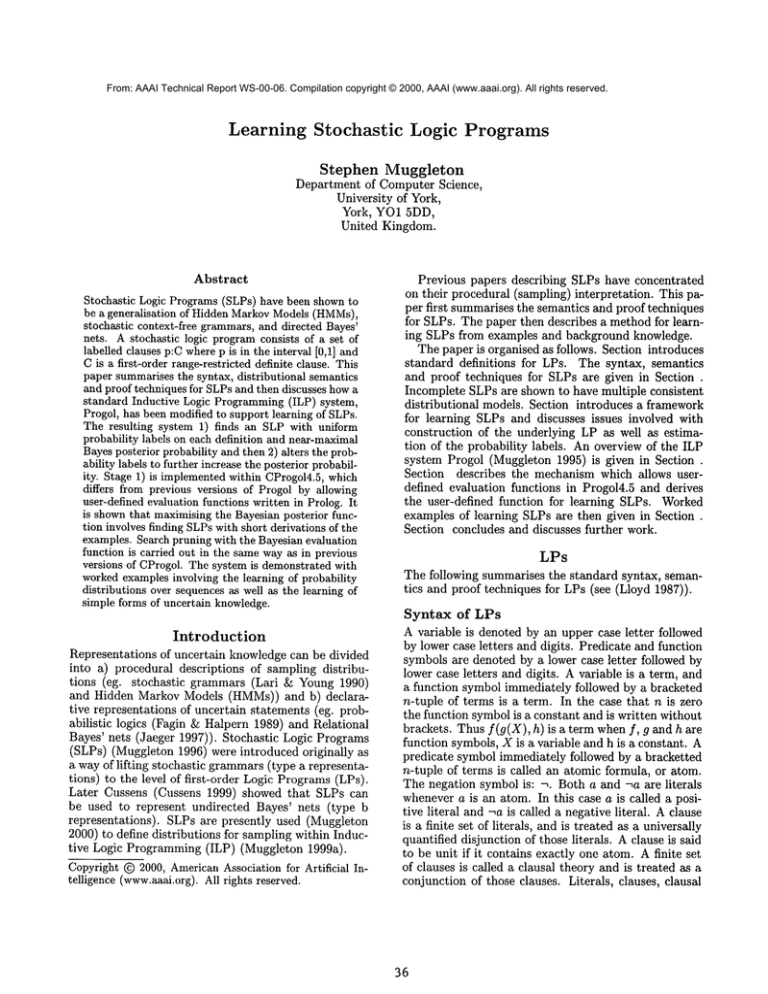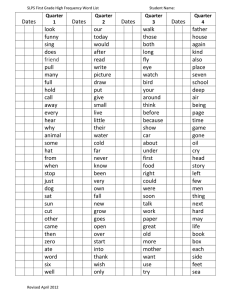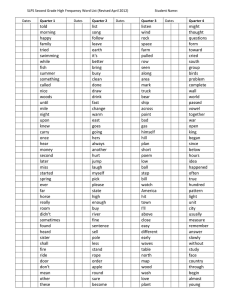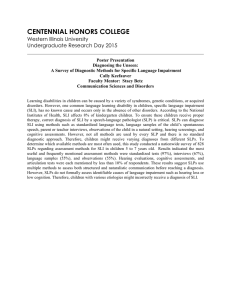
From: AAAI Technical Report WS-00-06. Compilation copyright © 2000, AAAI (www.aaai.org). All rights reserved.
Learning
Stochastic
Logic
Programs
Stephen Muggleton
Department of Computer Science,
University of York,
York, YO1 5DD,
United Kingdom.
Abstract
Stochastic Logic Programs (SLPs) have been shown
be a generalisation of Hidden MarkovModels(HMMs),
stochastic context-free grammars,and directed Bayes’
nets. A stochastic logic programconsists of a set of
labelled clauses p:C wherep is in the interval [0,1] and
C is a first-order range-restricted definite clause. This
paper summarisesthe syntax, distributional semantics
and proof techniques for SLPsand then discusses howa
standard Inductive Logic Programming(ILP) system,
Progol, has been modified to support learning of SLPs.
The resulting system 1) finds an SLP with uniform
probability labels on each definition and near-maximal
Bayesposterior probability and then 2) alters the probability labels to further increase the posterior probability. Stage 1) is implementedwithin CProgol4.5, which
differs from previous versions of Progol by allowing
user-defined evaluation functions written in Prolog. It
is shownthat maximisingthe Bayesian posterior function involves finding SLPswith short derivations of the
examples. Search pruning with the Bayesian evaluation
function is carried out in the samewayas in previous
versions of CProgol. The system is demonstratedwith
workedexamplesinvolving the learning of probability
distributions over sequencesas well as the learning of
simple forms of uncertain knowledge.
Introduction
Representations of uncertain knowledge can be divided
into a) procedural descriptions of sampling distributions (eg. stochastic grammars (Lari & Young 1990)
and Hidden Markov Models (HMMs)) and b) declarative representations of uncertain statements (eg. probabilistic logics (Fagin & Halpern 1989) and Relational
Bayes’ nets (Jaeger 1997)). Stochastic Logic Programs
(SLPs) (Muggleton 1996) were introduced originally
a way of lifting stochastic grammars(type a representations) to the level of first-order Logic Programs(LPs).
Later Cussens (Cussens 1999) showed that SLPs can
be used to represent undirected Bayes’ nets (type
representations).
SLPs are presently used (Muggleton
2000) to define distributions for sampling within Inductive Logic Programming (ILP) (Muggleton 1999a).
Copyright(~) 2000, AmericanAssociation for Artificial Intelligence (www.aaai.org).All rights reserved.
Previous papers describing SLPs have concentrated
on their procedural (sampling) interpretation. This paper first summarises the semantics and proof techniques
for SLPs. The paper then describes a method for learning SLPs from examples and background knowledge.
The paper is organised as follows. Section introduces
standard definitions for LPs. The syntax, semantics
and proof techniques for SLPs are given in Section .
Incomplete SLPs are shown to have multiple consistent
distributional models. Section introduces a framework
for learning SLPs and discusses issues involved with
construction of the underlying LP as well as estimation of the probability labels. An overview of the ILP
system Progol (Muggleton 1995) is given in Section
Section describes the mechanism which allows userdefined evaluation functions in Progol4.5 and derives
the user-defined function for learning SLPs. Worked
examples of learning SLPs are then given in Section .
Section concludes and discusses further work.
LPs
The following summarises the standard syntax, semantics and proof techniques for LPs (see (Lloyd 1987)).
Syntax of LPs
A variable is denoted by an upper case letter followed
by lower case letters and digits. Predicate and function
symbols are denoted by a lower case letter followed by
lower case letters and digits. A variable is a term, and
a function symbol immediately followed by a bracketed
n-tuple of terms is a term. In the case that n is zero
the function symbol is a constant and is written without
brackets. Thus f(g(X), is a t er m whe
n f, g a ndh ar e
function symbols, X is a variable and h is a constant. A
predicate symbol immediately followed by a bracketted
n-tuple of terms is called an atomic formula, or atom.
The negation symbol is: 4. Both a and ~a are literals
whenevera is an atom. In this case a is called a positive literal and -~a is called a negative literal. A clause
is a finite set of literals, and is treated as a universally
quantified disjunction of those literals. A clause is said
to be unit if it contains exactly one atom. A finite set
of clauses is called a clausal theory and is treated as a
conjunction of those clauses. Literals, clauses, clausal
theories, True and False are all well-formed-formulas
(wiTs). A wff or a term is said to be ground whenever
it contains no variables. A Horn clause is a clause containing at most one positive literal. A definite clause
is a clause containing exactly one positive literal and is
written as h +-- bl, .., bn whereh is the positive literal,
or head and the bi are negative literals, which together
constitute the body of the clause. A definite clause for
which all the variables in the head appear at least once
in the body is called range-restricted. A non-definite
Hornclause is called a goal and is written +-- bl, .., bn.
A Horn theory is a clausal theory containing only Horn
clauses. A definite programis a clausal theory containing only definite clauses. A range-restricted definite
program is a definite program in which all clauses are
range-restricted.
Semantics
F ~-I G. I is said to be refutation complete if I is complete with G restricted to False. The substitution t? is
said to be the unifier of the atoms a and a~ whenever
at? = a’t?. # is the most general unifier (mgu) of a and
a~ if and only if for all unifiers V of a and a~ there exists
a substitution 5 such that (a#)5 = 7. The r esolution
inference rule is as follows. ((C \ {a}) U (D \ {-~a’}))t?
said to be the resolvent of the clauses C and D whenever
C and D have no commonvariables,
a E C, -~a’ E D
and t? is the mguof a and a’. Suppose P is a definite
program and G is a goal. Resolution is linear when
D is restricted to clauses in P and C is either G or
the resolvent of another linear resolution. The resolvent of such a linear resolution is another goal. Assuming the literals in clauses are ordered, a linear resolution is SLDwhen the literal chosen to resolve on is the
first in C. An SLDrefutation from P is a sequence of
such SLDlinear resolutions, which can be represented
by Dp, G = (G, C1,..,Cn) where each Ci is in P and
the last resolvent is the empty clause (ie. False). The
answer substitution is t?p,c = t?lt?2..t?n where each t?i
is the substitution corresponding with the resolution
involving Ci in Dp, G. If P is range-restricted
then
t?p,G will be ground. SLDresolution is known to be
both sound and refutation complete for definite programs. Thus for a range-restricted definite program P
and ground atom a it can be shown that P ~ a by showing that P, <-- a }-SLD False. The Negation-by-Failure
(NF) inference rule says that P, +- a ~/SLDFalse implies
P [-SLDNF -~a.
of LPs
Let 0 = {vl/tl,
..,vn/tn}. 0 is said to be a substitution
wheneach vi is a variable and each ti is a term, and for
no distinct i and j is vi the same as vj. Greek lowercase letters are used to denote substitutions. 0 is said
to be ground when all ti are ground. Let E be a wff
or a term and 0 = {vl/tl,..,vn/tn}
be a substitution.
The instantiation of E by 0, written Et?, is formed by
replacing every occurrence of vi in E by ti. Et? is an
instance of E. Clause C t?-subsumes clause D, or C ___ D
iff there exists a substitution theta such that Ct? C D.
A first-order language L is a set of wffs which can
be formed from a fixed and finite set of predicate symbols, function symbols and variables. A set of ground
literals I is called an L-interpretation (or simply interpretation) in the case that it contains either a or --a for
each ground atom a in L. Let Mbe an interpretation
and C-- h +- B be adefinite clause in L. Mis said
to be an L-model (or simply model) of C iff for every
ground instance h~ +- Bt of C in L B~ _C Mimplies
h~ E M. Mis a model of Horn theory P whenever Mis
a model of each clause in P. P is said to be satisfiable
if it has at least one modeland unsatisfiable otherwise.
Suppose L is chosen to be the smallest first-order language involving at least one constant and the predicate
and function symbols of Horn theory P. In this case
an interpretation is called a Herbrandinterpretation of
P and the ground atomic subset of L is called the Herbrand Base of P. I is called a Herbrand model of Horn
theory P when I is both Herbrand and a model of P.
According to Herbrand’s theorem P is satisfiable iff it
has a Herbrand model. Let F and G be two wits. We
say that F entails G, or F ~ G, iff every model of F is
a model of G.
Proof
for
SLPs
Syntax
of SLPs
An SLP S is a set of labelled clauses p:C where p is a
probability (ie. a numberin the range [0, 1]) and C is
first-order range-restricted definite clause1. The subset
Sp of clauses in S with predicate symbol p in the head
is called the definition of p. For each definition Sp the
sum of probability labels ~rp must be at most 1. S is
said to be complete if ~rp = 1 for each p and incomplete otherwise. P(S) represents the definite program
consisting of all the clauses in S, with labels removed.
Example 1 Unbiased coin. The following
SLP is
complete and represents a coin which comes up either
heads or tails with probability 0.5.
S1-- { 0.5:coin(head)+-0.5 coin(tail) +-2.
$1 is a simple exampleof a sampling distribution
LPs
1Cussens(Cussens1999) considers a less restricted definition of SLPs.
:Section provides a more complexsampling distribution
a languageby attaching probability labels to productions of
a grammar. The grammaris encoded as a range-restricted
definite program.
An inference rule I = F --+ G states that wff F can
be rewritten by wff G. Wesay F ~-I G iff there exists
a series of applications of I which transform F to G.
I is said to be sound iff for each F t-i G always implies F ~ G and complete when F ~ G always implies
37
Example 2 Pet example. The following
complete.
SLP is in-
Example
S = 0.5:q(a)
+-{ 0.5:p(X)+--q(X)
$2={ 0.3 : likes(X,Y) +- pet(Y,X),pet(Z,X),cat(Y),mouse(Z)
}
Q(p(a)lS ) = 0.25 and Q(q(a)[S) 0. 5. L has pr edicate
symbols p, q and constant a, b.
$2 shows how statements of the form Pr(P(2)IQ(~7))
p can be encoded within an SLP, in this case
Pr(likes(X,Y) l... )) =
I1 = ( {l:p(a),O:p(b)}
{l:q(a),O:q(b)
Proof for SLPs
A Stochastic SLD (SSLD) refutation
is a sequence
Ds,a = (I:G, pl:C1,..,p,~:C,~)
in which G is a goal,
each pi:Ci E S and Dp(s),G ---- (G, C1,..,Cn) is
SLD refutation
from P(S). SSLD refutation
represents the repeated application of the SSLDinference
rule. This takes a goal p:G and a labelled clause q:C
and produces the labelled goal pq:R, where R is the
SLD resolvent
of G and C. The answer probability of Ds,a is Q(Ds,G) = 1-aLlPi" The incomplete
probability of any ground atom a with respect to S is
Q(alS) = ~Ds.(~-°) Q(Ds,(+-a)). Wecan state this
S I-SSLD Q(a]S) < Pr(aIS ) < 1, where Pr(alS ) represents the conditional probability of a given S.
Remark 3 Incomplete
probabilities.
If a is a
ground atom with predicate symbol p and the definition
Sp in SLP S is incomplete then Q(a[S) <_ rp.
Proof. Suppose the probability labels on clauses in Sp
are Pl, ..,Pn then Q(aIS) = plql + .. + pnq,~ where each
qi is a sum of products for which 0 < qi <_ 1. Thus
Q(alS) <_Pl + .. + Pn = 7rp.
Semantics
of SLPs
In this section we introduce the "normal" semantics of
SLPs. Suppose L is a first-order language and Dp is a
probability distribution over the ground atoms of p in
L. If I is a vector consisting of one such Dp for every
p in L then I is called a distributional L-interpretation
(or simply interpretation).
If a E L is an atom with
predicate symbol p and I is an interpretation then I(a)
is the probability of a according to Dp in I. SupposeL
is chosen to be the smallest first-order language involving at least one constant and the predicate and function
symbols of Horn theory P(S). In this case an interpretation is called a distributional Herbrandinterpretation
of S (or simply Herbrand interpretation).
Definition 4 An interpretation M is a distributional
L-model (or simply model) of SLP S iff Q(alS) ~_ M(a)
3.
for each ground atom a in L
Again if M is a model of S and M is Herbrand with
respect to S then Mis a distributional Herbrand model
of S (or simply Herbrand model).
3It might seemunreasonableto define semantics in terms
of proofs in this way. However,it should be noted that
Q(alS) represents a potentially infinite summationof the
probabilities of individual SSLDderivations. This is analogousto defining the satisfiability of a first-order formulain
terms of an infinite boolean expression derived from truth
tables of the connectives
5 Models.
I1 is a model of S.
I2 = {0.5:q(a),
0.5:q(b)
< {O.i.p(a),O.9:p(b)}
I2 is not a model of S.
Suppose S, T are SLPs. As usual we write S ~ Tiff
every model of S is a model of T.
Learning
SLPs
Bayes’ function
This section describes a frameworkfor learning a complete SLP S from examples E based on maximising
Bayesian posterior probability p(SIE). Belowit is assumedthat E consists of ground unit clauses. The posterior probability of S given E can be expressed using
Bayes’ theorem as follows.
(1)
R(SIE) B(S)p(E[S)
p(E)
p(S) represents a prior probability distribution over
SLPs. If we suppose (as is normal) that the ei are
chosen randomly and independently from some distribution D over the instance space X then p(EIS ) =
l-Iiml p(eilS). Weassume that p(eiIS) = Q(eilS) (see
Section ). p(E) is a normalising constant. Since the
probabilities involved in the Bayes’ function tend to
be small it makes sense to re-express Equation 1 in
information-theoretic terms by applying a negative log
transformation as follows.
m
-log2p(SIE) = -log2p(S)
- E[log2p(ei[S)]
(2
i=1
Here -log2p(S) can be viewed as expressing the
size (number of bits)
of S.
The quantity
m
-~i=l[log2p(eilS)]
can be viewed as the sum of sizes
(number of bits) of the derivations of each ei from
c is a constant representing log2p(E). Note that this
approach is similar to that described in (Muggleton
2000), differing only in the definition of p(eilS ). The
approach in (Muggleton 2000) uses p(eilS) to favour
LP hypotheses with low generality, while Equation 2
favours SLP hypotheses with a low mean derivation
size. Surprisingly this makes the Bayes’ function for
learning SLPs appropriate for finding LPs which have
low time-complexity with respect to the examples. For
instance, this function would prefer an SLP whose underlying LP represented quick-sort over one whose underlying LP represented insertion-sort since the mean
proof lengths of the former would be lower than those
of the latter.
38
Search strategy
The previous subsection leaves open the question of how
hypotheses are to be constructed and how search is to
be ordered. The approach taken in this paper involves
two stages.
1. LP construction.
Choose an SLP S with uniform
probability labels on each definition and near maximal posterior probability with respect to E.
2. Parameter estimation. Vary the labels on S to
increase the posterior probability with respect to E.
Progol4.5 is used to implement the search in Stage 1.
Stage 2 is implemented using an algorithm which assigns a label to each clause C in S according to the
Laplace corrected relative frequency with which C is
involved in proofs of the positive examples in E.
searches for the clause which maximisesthe information
compression within the following bounded sub-lattice.
[] -< H-< _1_
The hypothesised clause H is then added to the clause
base and the examples covered by H are removed. The
algorithm terminates when all examples have been covered. In the original version of Progol (CProgol4.1)
(Muggleton 1995) the search for each clause H involves
maximising the ’compression’ function
f = (p- (c+n + h))
where p and n are the number of positive and negative
examples covered by H, c is the number of literals in
H, and h is the minimumnumber of additional literals
required to complete the input/output variable chains
in H (computed by considering variable chains in 3-).
In later versions of Progol the following function was
used instead to reduce the degree of greediness in the
search.
m
f = p(p- (c+n + h))
(5)
Limitations
of strategy
The overall strategy is sub-optimal in the following
ways: a) the implementation of Stage 1 is approximate
since it involves a greedy clause-by-clause construction
of the SLPs, b) the implementation of Stage 2 is only
optimal in the case that each positive example has a
unique derivation.
This function estimates the overall global compression
expected of the final hypothesised set of clauses, extrapolated from local coverage and size properties of
the clause under construction. A hypothesised clause
H is pruned, together with all its more specific refinements, if either
Overview
of Progol
ILP systems take LPs representing background knowledge B and examples E and attempt to find the simplest consistent hypothesis H such that the following
holds.
BAH ~ E
(3)
This section briefly describes the ModeDirected Inverse
Entailment (MDIE) approach used in Progol (Muggleton 1995). Equation 3 is equivalent for all B, H and
to the following.
BAE
1 - c <0
(6)
P
or there exists a previously evaluated clause H’ such
that H’ is an acceptable solution (covers below the noise
threshold of negative examples and the input/output
variable chains are complete) and
H
Assuming that H and E are ground and that 3- is the
conjunctionof ground literals which are true in all models of B A E we have the following.
1 - _c < 1
p-
c’ + n’ + h’
p’
(7)
where p, c are associated with H and p’, n’, c’, h’ are
associated with Hq
BAE~_I_
Since H is true in every model of B A E it must contain
a subset of the ground literals in/. Hence
User-defined
evaluation
in Progol4.5
User-defined evaluation functions in Progol4.5 are implemented by allowing redefinition in Prolog of p, n
and c from Equation 5. Figure 1 shows the convention for names used in Progol4.5 for the built-in
and user-defined functions for these variables. Though
this approach to allowing definition of the evaluation
function is indirect, it means that the general criteria used in Progol for pruning the search (see Inequalities 6 and 7) can be applied unaltered as long
as user_pos_cover and user_neg_cover monotonically decrease and user_hyp_size monotonically increases with
downwardrefinement (addition of body literals) to the
hypothesised clause. For learning SLPs these functions
are derived below.
BAE~_I_~H
and so for all H
g ~ 3_
(4)
The set of solutions for H considered by Progol is restricted in a numberof ways. Firstly, _1_ is assumedto
contain only one positive literal and a finite numberof
negative literals. The set of negative literals in 3_ is
determined by mode declarations (statements concerning the input/output nature of predicate arguments and
their types) and user-defined restrictions on the depths
of variable chains.
Progol uses a covering algorithm which repeatedly
chooses an example e, forms an associated clause 3_ and
39
Variable
P
n
c
h
User-defined
user_poe_cover(P2)
user_neg_cover(N2)
user_hyp_size(C2)
user_hyp_rem(H2)
Built-in
pos_cover(P1)
neg_cover(N1)
hyp_size(C1)
hyp_rem(H1)
where I(x) -l og2x. Th e de gree of compression
achieved by an hypothesis is computed by subtracting
I(SIE) from I(S’ = EIE), the posterior information
of the hypothesis consisting of returning ungeneralised
examples.
(9)
+ ~ I(eilS)
P
~-~I(ejlH)) (10)
j=l
Following Stage 2 the labels are altered as ~llows to
reflectthe distribution ofclasstypes within thetrmning
data.
In Equation 10 extrapolation is made from the p positive examples covered by hypothesised clause H. Comparing Equations 5 and 10 the user-defined functions
of Figure 1 are as follows (p, n, c, h represent built-in
functions and p’,n’,c’,h’ represent their user-defined
counter-parts).
m)
p’ = p(1 4-1og2
(11)
0.238:class(A,reptile)
has_legs(A,4),
has_eggs(A).
0.238:class(A,mammal)
:- has milk(A).
0.238:class(A,fish):- has gills(A).
0.095: class(A,reptile)
has_legs(A,O),
habitat(A,land).
0.190:class(A,bird)
has_covering(A,feathers).
97t
n
j~-I
~
np(S1,S2) :- det(S1,S3), noun(S3,S2).
tion )the SLP constructed has uni~rm probability la4.
bels as ~llows
0.200: class(h,reptile)
has_legs(A,4),
has_eggs(A).
0.200: class(A,mammal)
:- has milk(A).
0.200: class(A,fish)
:- has gills(A).
0.200: class(A,reptile)
has_legs(A,O),
habitat(A,land).
0.200: class(A,bird)
has_covering(A,feathers).
i=l
C’
Background
knowledge
Figure 3: Examples and background knowledge for Simple English Grammar.
m
n’ = ~ I(ejlg)
s ([the,man,walks,the,dog], ~).
s ([the, dog,walks,to ,the ,man],~ ).
noun([manlS],S).
The compression induced by S with respect to E is now
simply the difference between Equations 9 and 8, which
is as follows.
= m---(p(1 + log2m) - I(H) 4P
Examples
(S)
i=l
m(1 + log2m) - I(S)
has_covering(dog,hair).
Figure 2: Examples and background knowledge for animal taxonomy.
m
= E[E) = I(E) + I(E[S’ = E)
-- m 4- mlog2m4- c
= m(1 +log2m ) + c
Background
knowledge
...
Equation 2 can be rewritten in terms of an information function I as
I(S’
class(dog,mammal).
class(trout,fish).
iaasAegs(dolphin,0).
Figure h Built-in and user defined predicates for some
of the variables from Equation 5.
I(SJE)
= I(S)
- X(e,
lS)
Examples
e
h’ = h
Simple English
grammar
Figure 3 shows the examples and background knowledge for an exampleset which involves learning a simple
English grammar. Following Stage 2 the learned SLP
is as follows.
0.438: s(h,B) :- np(h,C), vp(C,D),
np(D,B).
Worked
examples
The source code of Progol4.5 together with the input
files for the following workedexamples can be obtained
from ftp: / /ftp.cs. york.ac.uk/pub /mlg/progol4.5 / .
Animal taxonomy
Figure 2 shows the examples and background knowledge for an example set which involves learning taxonomic descriptions of animals. Following Stage 1 (Sec-
4Forthisexample
andthenextthevalueof p’ (Equationii)wasincreased
by a factor
of4 toachieve
positive
compression
4O
0.562: s(A,B):- np(A,C),verb(C,D),
np(D,E),prep(E,F),np(F,B).
Lloyd, J. 1987. Foundations of Logic Programming.
Berlin: Springer-Verlag. Second edition.
Muggleton, S. 1995. Inverse entailment and Progol.
New Generation Computing 13:245-286.
Muggleton, S. 1996. Stochastic logic programs. In
de Raedt, L., ed., Advances in Inductive Logic Programming. IOS Press. 254-264.
Muggleton, S. 1999a. Inductive logic programming:
issues, results and the LLLchallenge. Artificial Intelligence 114(1-2):283-296.
Muggleton, S. 1999b. Scientific knowledge discovery
using inductive logic programming. Communications
of the ACM42(11):42-46.
Muggleton, S. 2000. Learning from positive data. Machine Learning. Accepted subject to revision.
Conclusion
This paper describes a method for learning SLPs from
examples and background knowledge. The method is
based on an approximate
Bayes MAP (Maximum
Posterior probability) algorithm. The implementation
within Progol4.5 is efficient and produces meaningful
solutions on simple domains. However, as pointed out
in Section the method does not find optimal solutions.
The author views the method described as a first attempt at a hard problem. It is believed that improvements to the search strategy can be made. This is an
interesting topic for further research.
The author believes that learning of SLPs is of potential interest in all domainsin which ILP has had success (Muggleton 1999a). In these domainsit is believed
that SLPs would the advantage over LPs of producing predictions with attached degrees of certainty. In
the case of multiple predictions, the probability labels
would allow for relative ranking. This is of particular importance for Natural Language domains, though
would also have general application in Bioinformatics
(Muggleton 1999b).
Acknowledgements
The author would like to thank Wray Buntine, David
Page, Koichi Furukawa and James Cussens for discussions on the topic of Stochastic Logic Programming.
Many thanks are due to my wife, Thirza and daughter
Clare for the support and happiness they give me. This
work was supported partly by the Esprit RTDproject
"ALADIN’ (project
28623), EPSRC grant "Closed
Loop Machine Learning", BBSRC/EPSRCgrant "Protein structure prediction - development and benchmarking of machine learning algorithms" and EPSRCROPA
grant "Machine Learning of Natural Language in a
Computational Logic Framework".
References
Cussens, J. 1999. Loglinear models for first-order
probabilistic reasoning. In Proceedings of the 15th Annual Conference on Uncertainty in Artificial Intelligence, 126-133. San Francisco: Kaufmann.
Fagin, R., and Halpern, J. 1989. Uncertainty, belief
and probability. In Proceedings of IJCAI-89. San Mateo, CA: Morgan Kauffman.
Jaeger, M. 1997. Relational bayesian networks. In
Proceedings of the Thirteenth Annual Conference on
Uncertainty in Artificial Intelligence. San Francisco,
CA: Kaufmann.
Lari, K., and Young, S. J. 1990. The estimation
of stochastic context-free grammarsusing the insideoutside algorithm. Computer Speech and Language
4:35-56.
41






